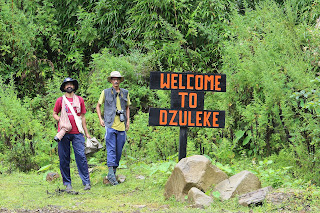ഇതൊരു അപൂര്വ്വാനുഭവം,വടക്കന് കേരളത്തില് നിന്നും അഞ്ഞൂറോളം കിലോമീറ്ററുകള് താണ്ടി അത്യുന്നതമായ ഈ ഗിരിമകുടത്തിന്റെ ഗരിമയും ഗാംഭീര്യവും ഒപ്പം ഭയാനകതയും ആവോളം അനുഭവിക്കുക,കാടുകളും മേടുകളും ചോലകളും മുളങ്കൂട്ടങ്ങളും വഴി തുറന്നുതന്നത് ഈ സ്വപ്നസമാന അന്തരീക്ഷത്തിലേക്കായിരുന്നു.വന്യവും വശ്യവും ആയ ഈ കാഴ്ച തികച്ചും അവര്ണ്ണനീയം.
തിരുവനന്തപുരത്തിനു കിഴക്ക് പശ്ചിമഘട്ടമലനിരകളിലുള്ള അഗസ്ത്യകൂടത്തിലേക്കാണ് ഈ യാത്ര.എല്ലാവര്ഷവും ശിവരാത്രിക്ക് മുന്നേയുള്ള ഒരു മാസക്കാലം മാത്രമാണ് വനംവകുപ്പ് ഇവിടേക്ക് തീര്ത്ഥാടകരേയും സഞ്ചാരികളേയും അനുവദിക്കുന്നത്.അതും മുന്കൂട്ടി പ്രവേശനപാസ്സ് മൂലം എണ്ണം പരിമിതപ്പെടുത്തിക്കൊണ്ട്.2001 ല് രൂപീകരിച്ച അഗസ്ത്യവനം ബയോസ്ഫിയര് റിസര്വ്വില്പെട്ട അഗസ്ത്യകൂടംകൊടുമുടിക്ക് 1866 മീറ്റര് ഉയരമുണ്ട്,2695 മീറ്റര് ഉള്ള ആനമുടിക്ക് തൊട്ടുപിന്നില് രണ്ടാം സ്ഥാനത്ത്.ഈയൊരു കൊടുമുടി കയറുക എന്ന ലക്ഷ്യവുമായാണ് ഞങ്ങളുടെ അഞ്ചംഗസംഘം യാത്ര തുടങ്ങിയത്.
തിരുവനന്തപുരത്തിന് കിഴക്ക് എഴുപതോളം കിലോമീറ്ററുകള് വളഞ്ഞുപുളഞ്ഞ് കയറി,പത്തോളം ഹെയര്പിന് വളവുകള്തിരിഞ്ഞ് കെ.എസ്.ആര്.ടി.സിയുടെ പകുതി ബസ്സ് ചെന്നുനിന്നത് ബോണക്കാട് തേയിലക്കമ്പനിയുടെ ഇടിഞ്ഞ് പൊളിയാറായ ഓഫീസിനുമുന്നില്.തുരുമ്പെടുത്ത നഷ്ടപ്രതാപങ്ങളുമായി ആ മലഞ്ചെരുവില് അങ്ങനെനില്ക്കുന്ന ആ കെട്ടിടസമുച്ചയം ഒരു ഭീകരസത്വത്തിന്റെ പ്രതീതി ജനിപ്പിച്ചു.ഗേറ്റിനുമുന്നിലുള്ള അനുവാദമില്ലാതെ പ്രവേശനമില്ലെന്ന ബോര്ഡും അവഗണിച്ച് യാത്രതുടര്ന്ന ഞങ്ങളുടെ സംഘം രണ്ടുകിലോമീറ്ററുകള്ക്കപ്പുറത്തുള്ള വനംവകുപ്പിന്റെ ചെക്ക്പോസ്റ്റ് ലക്ഷ്യമാക്കി.ആള്വാസം കുറഞ്ഞപഴയവീടുകളും വളര്ച്ചമുരടിച്ച് ഉപേക്ഷിക്കപ്പെട്ട തേയിലത്തോട്ടങ്ങളും സമ്പന്നവും തിരക്ക്പിടിച്ചതുമായ ഒരു ഭൂതകാലത്തിന്റെ ശേഷപത്രമെന്ന് തീര്ച്ച.വയനാടന്കാടുകളോട് സാമ്യമുള്ള കാടുകളിലൂടെ രണ്ട് മൂന്ന് കിലോമീറ്ററുകള്ക്കപ്പുറം അല്പം ഉയരത്തില് ഒരു ചെറിയകെട്ടിടം-വനംവകുപ്പുകാരുടെ പരിശോധനാകേന്ദ്രം.ഒരുവശത്ത് യാത്രികരുടെ ബൈക്കുകള് നിരനിരയായി.നാല്പതില്പ്പരം പേര് കൌണ്ടറിനുമുന്നില്.ബര്മുഡയും ട്രക്കിംഗ്ഷൂസും കറുത്തകണ്ണടയും വെച്ച് അടിമുടിചെത്തിനടക്കാന് വന്നവര് മുതല് കാവിയണിഞ്ഞ് ഭസ്മംപൂശി ജടാമകുടങ്ങള് നീട്ടിവളര്ത്തിയവര് വരെ.ഏവര്ക്കും ഒരേ ലക്ഷ്യം.മുപ്പതോളം കിലോമീറ്ററുകള്ക്കപ്പുറമുള്ള അഗസ്ത്യകൂടമലനിരകളുടെ നെറുകയിലെത്തെണം.ദ്വിദിനയാത്രക്കുള്ള ഭാണ്ഡക്കെട്ടുകളില് പഴവുംഅവിലും മലരും തൊട്ട് ബര്ഗറും ചീസും ഗ്ളൂക്കോസും 'റെഡ്ബുളും'വരെ. സര്വ്വംമറന്ന് ആഹ്ളാദിക്കാനെത്തിയവര്, സര്വ്വംതൊഴുത് ഭക്തിയില് ആറാടുന്നവര്,ഒപ്പം ഈ വനാന്തരത്തിലെ ആറുകളിലും ചോലകളിലും സസ്യങ്ങളിലും പക്ഷികളിലും സര്വ്വചരാചരങ്ങളിലും സാക്ഷാത്ക്കാരം തേടുന്ന മറ്റുചിലരും-അങ്ങിനെപോയി ആ വൈവിധ്യം. ഊഴമനുസരിച്ച് പേരുവിളിച്ച് ഐഡന്റിറ്റി ഉറപ്പിച്ചതിനുശേഷം സര്വ്വഭാണ്ഢങ്ങളും അഴിച്ചെടുത്തൊരു പരിശോധന. മദ്യവും മറ്റും കൊണ്ടുപോകുന്നത് തടയാനാണത്രെ ഇത്. ഒരു വനവാസി വഴികാട്ടിയായി മുന്നില്. വരണ്ട കാടുകള്,മലമടക്കുകളോട് ചേര്ന്ന് ഇരുണ്ടകാടുകള്.നീര്ച്ചാലുകളും അരുവികളും പാറക്കൂട്ടങ്ങളില് തട്ടിച്ചിതറുന്നു,പൊട്ടിച്ചിരിക്കുന്നു.കിലോമീറ്ററുകള് ദൃശ്യങ്ങളുടെ തനിയാവര്ത്തനം.
ലാത്തിമൊട്ടയെന്ന ഒന്നാം ക്യാമ്പില് വെച്ച് വഴികാട്ടി മാറുന്നു.സാമാന്യം ദീര്ഘങ്ങളായ കയറ്റങ്ങളും ചെറുചെറു ഇറക്കങ്ങളും.വിശ്രമഇടവേളകളുടെ ആവൃത്തിയും ദൈര്ഘ്യവും കൂടുന്നു.സഞ്ചിയിലെ പഴങ്ങളുടെ ഏണ്ണവും കുറയുന്നു.കരമനയാറുംനെയ്യാറും ഉള്പ്പെടെ തിരുവനന്തപുരം ജില്ലയിലെ ഒട്ടുമിക്ക പ്രവാഹങ്ങളുടെയും തുടക്കം ഈ മലഞ്ചെരിവുകളില്നിന്ന്.പലതും മുറിച്ച്കടന്നും നനഞ്ഞ് കയറിയും കുപ്പികളില് ദാഹജലമായി നിറച്ചും കുടിച്ചും ഒരു മണിയോടെ അട്ടയാറെന്ന നീര്ച്ചോലയുടെ തീരത്ത് ഉച്ചഭക്ഷണപ്പൊതികളഴിക്കുന്നു. മുന്നേ നടന്നവരും തിരിച്ചിറങ്ങുന്നവരും മരമുത്തശ്ശന്മാരുടെ കാല്ക്കീഴില് വിശപ്പടക്കുന്നു, വിശ്രമിക്കുന്നു.സമീപം വഴികാട്ടികളായ വനവാസിസഹോദരന്മാര്ക്കുള്ള ഭക്ഷണം തയ്യാറാക്കി അവരും കഴിക്കുന്നു. ഭക്ഷണത്തിനു ശേഷം അട്ടയാറിലെ തെളിനീര് ആവോളം കോരിക്കുടിച്ച് അല്പമൊന്ന് വിശ്രമിക്കുമ്പോഴേക്കും പുതിയവഴികാട്ടിയായ ചന്ദ്രന്കാണിയുടെ നിര്ദ്ദേശം, നേരം പോകുന്നു...ഇനിയുള്ളത് ആനക്കാടുകള്.
വീണ്ടും കയറ്റം.പക്ഷെ ഇപ്പോള് വഴിക്കിരുവശവും രണ്ടാള് ഉയരത്തില് പുല്മേടുകള്,മലമടക്കുകളോട് ചേര്ന്ന് മുളങ്കാടുകള്. ആനകള്ക്ക് ഏറ്റവും ഇഷ്ടപ്പെട്ട ഈ ആവാസം നോക്കെത്താദൂരത്തില് ഉയര്ന്ന്പരന്ന് കിടക്കുന്നു. ഒപ്പമുള്ളവരെ പിന്നിലാക്കി ചന്ദ്രന്കാണിക്കൊപ്പം കിതപ്പോടെ വേഗതകൂട്ടി.ചില വിവരങ്ങള് കൈക്കലാക്കുകയായിരുന്നു ഉദ്ദേശ്യം. കാടിന്റെ സ്വഭാവവും പ്രകൃതവും ജനിച്ചപ്പോള്തൊട്ട് പരിചയമുള്ള ആ നിഷ്കളങ്കന് തന്റെ സ്വതസിദ്ധമായ ഭാഷയില് കഴിഞ്ഞതീര്ത്ഥാടനക്കാലത്ത് ആനക്കൂട്ടം രണ്ടുപേരെക്കൊന്നതും മറ്റും മറ്റും വിവരിച്ചു.മുന്നിലകപ്പെട്ട ആനക്കൂട്ടത്തെ ക്യാമറയിലാക്കാന് ശ്രമിച്ചപ്പോള് ആദ്യമൊന്ന് പോസുചെയ്തവര്, ബഹളവും ഫ്ളാഷിന്റെ തീവ്രതയും കൂടിയപ്പോള് യാത്രികര്ക്ക് നേരെ തിരിഞ്ഞു. കാട്ടിലും സൈര്യം കൊടുക്കാഞ്ഞാല്? കഥകേട്ടതോടെ പുല്മേടുകള്ക്കിടയിലെ ഓരോ പാറക്കൂട്ടവും ചലിക്കുന്നതുപോലെ! അഗസ്ത്യകൂടത്തിന്റെ മാത്രം പ്രത്യേകതകളായ ആരോഗ്യപ്പച്ചയേക്കുറിച്ചും കല്ലാനകളേക്കുറിച്ചും ആരാഞ്ഞു. വനവാസികള് മരുന്നായും ഭക്ഷണമായും ഉപയോഗിക്കുന്ന ആ ആരോഗ്യപ്പച്ച യാത്രാവഴിയില് കണ്ടുകിട്ടാന് സാധ്യതയില്ലന്നെറിഞ്ഞപ്പോള് വിഷമം തോന്നി.വനാന്തരങ്ങളിലെ കോളനികളിലുള്ള സര്വ്വശിക്ഷാഅഭിയാന്റെവിദ്യാലയങ്ങളെക്കുറിച്ചുംഅതിന്റെശോചനീയാവസ്ഥയെക്കുറിച്ചുംസൂചിപ്പിച്ചു.വനവാസികളുടെഇടയില്യോഗ്യതയുള്ളവരുണ്ടായിട്ടുംപുറമേനിന്നുള്ളവരെ നിയമിക്കുന്നതാണ് നിലവാരതകര്ച്ചക്ക് ഒരു കാരണമെന്ന്പലരും സൂചിപ്പിച്ചു.വനംവകുപ്പുകാരും ജന്തുശാസ്ത്രജ്ഞന്മാരുംഇനിയും അംഗീകരിച്ചിട്ടില്ലാത്ത കല്ലാനകളെ അദ്ദേഹം നേരിട്ടുകണ്ടിട്ടുള്ളകാര്യവും അല്ഭുതത്തോടെയാണ് കേട്ടത്.കല്ലാനകള് കൂടുതല് അക്രമാസക്തരും വലിയ ഓട്ടക്കാരും ആണത്രെ.ചില ഫോട്ടോഗ്രാഫര്മാര് ഈയ്യിടെ കല്ലാനകളുടെ ഫോട്ടോഎടുത്ത വിവരം മാധ്യമങ്ങളില് വന്നിരുന്നു.
പുല്മേടുകളുടെ അവസാനം ചെങ്കുത്തായ മലമടക്കുകളുടെ ആരംഭം.അറുപതും എഴുപതും ഡിഗ്രിചെരിവുണ്ടെന്നു തോന്നുന്നു.യാത്രികരെല്ലാംപത്തടി നടന്ന്,അഞ്ച് മിനുട്ട് നില്പുംഇരിപ്പും എന്നനിലയിലായി.എത്രസമയം?എത്ര ചെരിവുകള്? ഒരു ധാരണയും ഇല്ല.അവസാനം മലകള് ഇരിന്നുതുടങ്ങി.വഴിയിലുടനീളം മരങ്ങളുടെ കീഴിലും കല്ലുകളുടെ മുകളിലും മഞ്ഞള്പ്പൊടിയും ഭസ്മവും വാരിവിതറിയിരിക്കുന്നു.കല്ലിലുംമരത്തിലും പരമാത്മദര്ശനം നടത്തുന്ന വിശിഷ്ടമായ കാഴ്ചപ്പാട്.എല്ലാംഒന്നാകുന്ന അദ്വൈതം! കാട്ടുപാത നീണ്ടുചെന്നത് ആദ്യദിവസത്തെ ഇടത്താവളമായ അതിരുമല ഡോര്മിറ്ററിയിലേക്ക്.
സമയം വൈകുന്നേരം അഞ്ചുമണി.കരിങ്കല്ല് കൊണ്ടുനിര്മ്മിച്ച വിശാലമായ കെട്ടിടം.വൃത്തിയുംവെളിച്ചവും തീരെ കുറവ്.യാത്രാസംഘങ്ങള് തലങ്ങും വിലങ്ങുമായി നടുനിവര്ക്കുന്നു,പുലര്ച്ചെതുടങ്ങിയ യാത്രയുടെ ക്ഷീണവുമായി.മുഖമൊന്ന് കഴുകിയപ്പോഴേക്കും കുളിക്കാനുള്ളആഗ്രഹംഉപേക്ഷിച്ചു.അത്രയ്ക്കുണ്ട്കുളിര്പുറത്തിറങ്ങി.തണുത്തകാറ്റ്ചീറിയടിക്കുന്നു. തൊട്ടടുത്തുള്ള വനസംരക്ഷണസമിതിയുടെ മുളകൊണ്ടു നിര്മ്മിച്ച താല്ക്കാലിക കേന്റീനില്നിന്നും ആവിപാറുന്ന കട്ടന്കാപ്പി കുടിച്ചു.വലിയആശ്വാസം!പുറത്തിറങ്ങിയപ്പോഴേക്കും കാറ്റിന്റെ ശക്തി ഇരട്ടിച്ചതുപോലെ,ഇളകിയാടുന്ന മരച്ചില്ലകളുടെ നിലയ്ക്കാത്ത ശബ്ദഘോഷം., ഇന്നു പൌര്ണ്ണമി,മാനത്ത് പൂര്ണ്ണചന്ദ്രന്-മനസ്സിലും. നേരെ മുന്നില് ദൂരെ ഉയര്ന്നു നില്ക്കുന്നു അഗസ്ത്യകൂടം! വെണ്നിലാപ്പാല്ക്കടലില് മുങ്ങിക്കുളിച്ച്, ആപാദചൂഢം മേഘമാലകളാല് അലംകൃതമായി.ആ വിസ്മയലോകത്ത് തിങ്കളും മേഘങ്ങളുംനക്ഷത്രങ്ങളും അഗസ്ത്യശൃംഖത്തോട് ഒളിച്ച്കളിക്കുന്നതു പോലെ.ഈ ദൃശ്യമാസ്മരികതയില് നിര്വൃതിപൂകി മുറ്റത്ത് അങ്ങിങ്ങായി ചിതറിനില്ക്കുന്നു ആള്ക്കൂട്ടങ്ങള്. പൊള്ളുന്ന കഞ്ഞിയും പയറും പപ്പടവും കൊണ്ട് വയറുനിറച്ച് പുതപ്പിനുള്ളിലേക്ക്,അഗസ്ത്യശിഖരവും സ്വപ്നത്തിലേറ്റി.
അസ്ഥിതുളക്കുന്ന തണുപ്പില് കാന്റീനില്നിന്നുംഉപ്പുമാവുംകഴിച്ച് ചെറുഭാണ്ഡവും പേറി യാത്രസംഘത്തിലെ അവസാനകൂട്ടമായി ലക്ഷ്യസ്ഥാനത്തേക്ക് പുറപ്പെട്ടു.ആറുകിലോമീറ്ററുകള് കുത്തനെ താണ്ടണം.അല്പം മഴക്കാടും പിന്നെമുളങ്കാടുംകഴിഞ്ഞ് എത്തിയത് വിശാലമായ പാറപരപ്പിലേക്ക്.ഒരു ഹോളിവുഡ് സിനിമാദൃശ്യം പോലെ. നാലുഭാഗവും മലകള്,മലകളില് നിന്നും നീര്ച്ചാലുകള്, മലമടക്കുകള്ക്കിടയില് ചോലക്കാടുകള്.പാറക്കെട്ടിലെ അല്പം ജലത്തില് മുഖംകഴുകി,വലതുകൈ ചലിക്കുന്നില്ല!തണുത്ത് മരവിച്ചിരിക്കുന്നു.വീണ്ടും ഉയരങ്ങളിലേക്ക്, മഞ്ഞയും ചുവപ്പും നീലയും വര്ണ്ണങ്ങളില് ചെടികളും ചെറുമരങ്ങളും പൂത്തുലഞ്ഞു നില്ക്കുന്നു. കള്ളിച്ചെടികള്, നിരവധി ഇനങ്ങളില്പ്പെട്ട ഓര്ക്കിഡുകള്, അതിരാണിയുടേയും കോളാമ്പിയുടേയും കുഞ്ഞനുജത്തിമാര്,അതോ ചേച്ചിമാരോ? നടന്നു കയറിയത് തമിഴ് മണ്ണിലേക്കെന്ന് ആരോപറയുന്നു.ഒരു വശത്ത് നെയ്യാറും പേപ്പാറയും മറുവശത്ത് താമ്രപര്ണ്ണിയും പേരറിയാത്ത മറ്റ് പലതും പരിചയമുള്ളവര് ചൂണ്ടിക്കാട്ടുന്നു.ആരോഹണം തീര്ത്തും കുത്തനെയായി.മരക്കുറ്റികളില് കെട്ടിയകയറിലായി പലസ്ഥലത്തും കയറ്റം.വെള്ളക്കുപ്പികളും ഗ്ളൂക്കോസ് പാക്കറ്റുകളും അതിവേഗം കാലിയാവുന്നു.ഇരുന്നും നിരങ്ങിയും പതുക്കെ മുകളിലേക്ക്."നോവിന്റെ ശൂലമുനമുകളില്" കയറിയഅവസ്ഥ.താഴെ വിദൂരതയില് അഞ്ചുമലകള് ചേര്ന്ന പാണ്ഡവന്മലയും കവരുമലയും, ഉറുമ്പിന്നിരകള് പോലെ ദൂരെ മടക്കയാത്രയില് ഏര്പ്പെട്ടവര്.
''ഒടുവില് നാമെത്തി ആ ശൈലശൃംഖത്തിന്റെ കൊടുമുടിയില്”-പന്ത്രണ്ടുമണിയോടെ. ഈ'നാരായ ബിന്ദുവില്' അഗസ്ത്യമുനിയുടെ ഒരുചെറുകരിങ്കല് പ്രതിമയും ദര്ശനപുണ്യം തേടിയെത്തിയ രണ്ടോ മൂന്നോ തീര്ത്ഥാടകസംഘങ്ങളും മാത്രം.കോടമഞ്ഞ് വന്നും പോയും. മറുവശത്ത് നൂറ് കണക്കിന് മീറ്റര് കുത്തനെ താഴ്ച.പക്ഷെ മഞ്ഞ് കാരണം ഒന്നും കാണാനില്ല.കാറ്റ് തച്ചുതകര്ക്കുന്നു. കൊടും ഭയം,കാറ്റ് തട്ടിയെടുത്താല് ഒരു പക്ഷെ അത്യാഗാധതയിലാവാം നിലം തൊടുന്നത്. ആരോ ഉയര്ത്തിയ ദേശീയപതാക കാറ്റില് അടിച്ചുപറക്കുന്നു.ഒരു അന്യഗ്രഹത്തിലെത്തിയ പ്രതീതീയുമായി ആ വന്യവിസ്മയത്തില് അല്പസമയം ഇരുന്നു.
കാറ്റ് ചീറിയടിക്കുന്ന് അവിടെനിന്നും തെല്ല് മാറി കാറ്റേറ്റ് ചുരുണ്ട് കുറുകിയ ശാഖകളോട് കൂടിയ മരങ്ങള്ക്കിടയില് അഗസ്ത്യന്റെ പ്രതിമയ്ക്ക് ചുറ്റും രണ്ട് മൂന്ന് സംഘങ്ങളിലായി പത്ത് പതിനഞ്ച്പേര്. യാത്ര തുടങ്ങിയസ്ഥലത്ത് തൊട്ട് കൈയ്യിലേന്തിയ പാലും തേനും ഭസ്മവും ഒപ്പം ജലവും ഫലവര്ഗ്ഗങ്ങളും പ്രതിമയില് അഭിഷേകം ചെയ്യുന്നു, കര്പ്പൂരാരതി ഉഴിയുന്നു, കണ്ണുകളടച്ച് ധ്യാനനിമഗ്നരാവുന്നു.തുടര്ന്ന് അടുത്ത സംഘത്തിന്റെ ഊഴം.അഭിഷേകാവശിഷ്ടങ്ങളും മറ്റും വളരെവൃത്തിയില് കഴുകിമാറ്റി തുടച്ചുവൃത്തിയാക്കി അവരും പൂജകള് തുടരുന്നു.അവരുടെ പ്രവൃത്തികളിലെ ശ്രദ്ധയും ഭാവവും വിശ്വാസത്തിന്റെ ശക്തിയും തീവ്രതയും വിളിച്ചോതി. ഈ വിശ്വാസം തന്നെയാകാം വൃദ്ധരെക്കൊണ്ടുപോലും വളരെ ലാഘവത്തോടെ ഈ കൊടുമുടി ഏറാന് സഹായിക്കുന്നതും.
അവസാനസംഘത്തിന്റെ അഭിഷേകവും അവസാനിച്ചു.സമയം ഒരു മണി.ഇറങ്ങാനുള്ള ദുര്ഘടപാതകളും ഒപ്പം ആനക്കാടുകളും കോടക്കാറുകളും യാത്രികരെ ധൃതിയിലുള്ള തിരിച്ചിറക്കത്തിന് പ്രേരിപ്പിച്ചു.പൂജാവസ്തുക്കളിലെ ഏതാനും ഫലവര്ഗ്ഗങ്ങളുമെടുത്ത് വഴികാട്ടിയായ വനവാസി ഏറ്റവും പിന്നിലായി.അവശേഷിക്കുന്ന പഴങ്ങള് ആനകളും മറ്റ് ജീവികളും കൊണ്ടുപോകുമത്രെ.ഈ നെടുങ്കന് പാറക്കൂട്ടങ്ങളും കയറി ആനക്കൂട്ടങ്ങള് എത്തുന്നത് മനസ്സില് കണ്ടു. കോടക്കാറുകള് മാനം നിറഞ്ഞപ്പോള് നട്ടുച്ചക്കും കൂരുരിട്ട്,ഇനിയവിടെ ചീറിയടിക്കുന്ന കാറ്റും സര്വ്വതിനും സാക്ഷിയും സംരക്ഷകനും ആയി അഗസ്ത്യനും മാത്രം............










